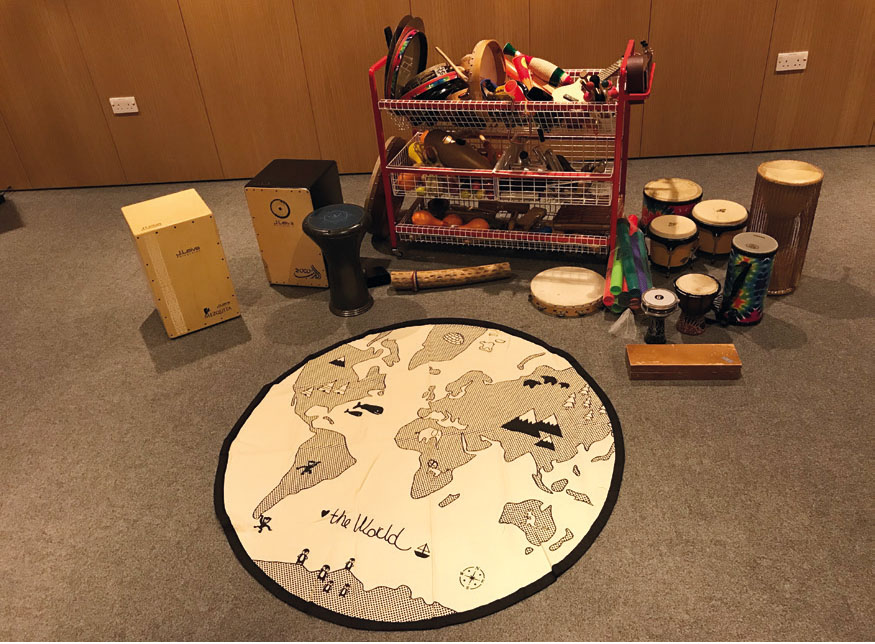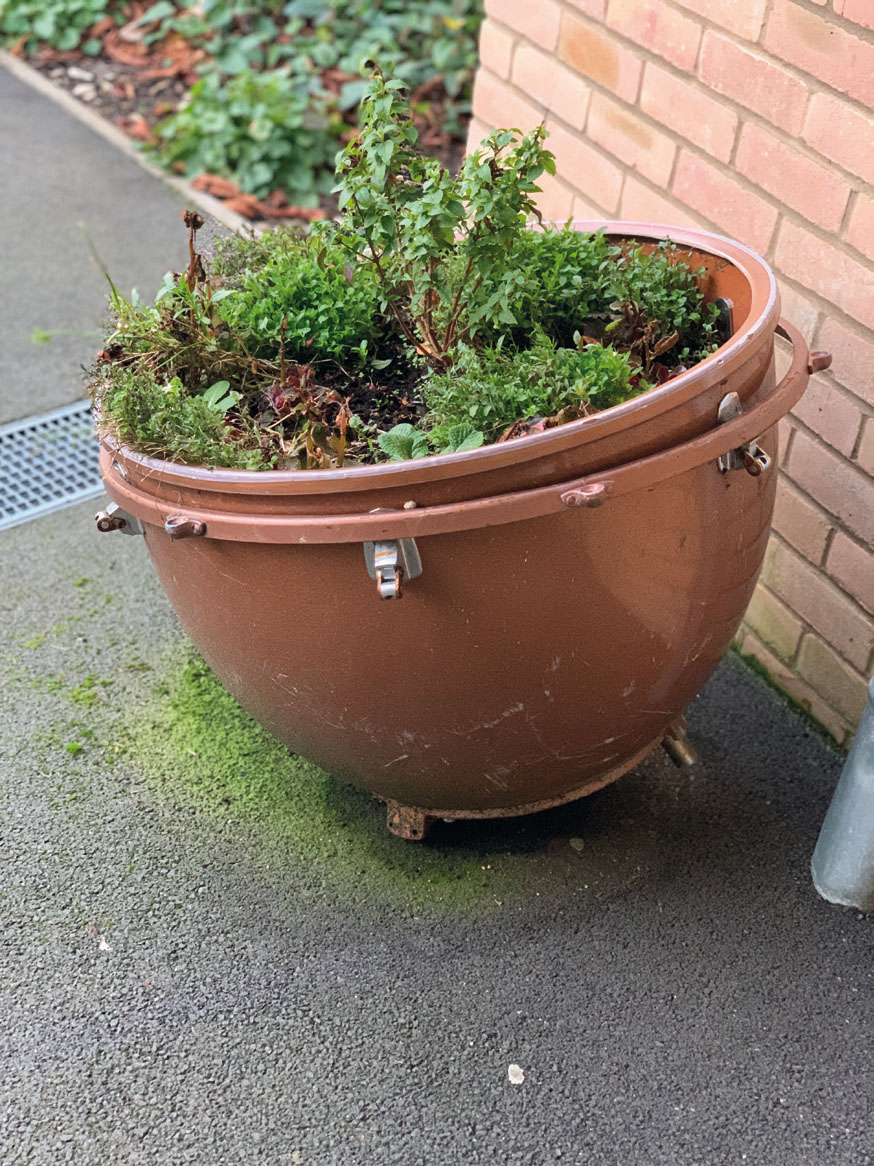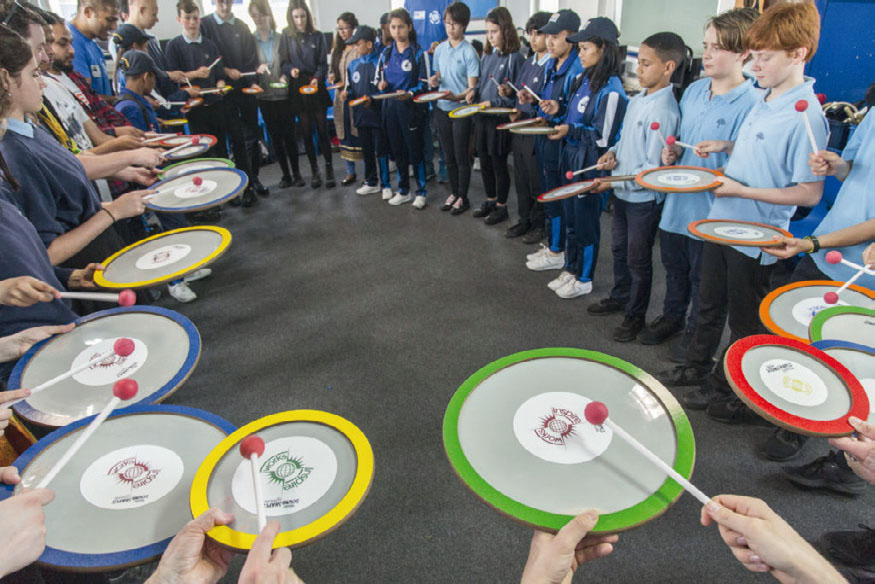
The percussion trolley found in almost every school is often full of instruments that no one knows the names of, how to play, what combinations to put them in, and whether they are broken or usable. This is reminiscent of a kitchen cupboard full of mysterious unused spices that we don't know how to use. Just as a chef could look in a kitchen cupboard and use their training, experience, and knowledge to make an amazing meal, I shall attempt to take you through some simple, creative, inventive, and affordable ways to use percussion instruments you already own in ways that you might not have thought of before.
Arranging the instruments on the trolley
In all the schools I've visited, I've seen countless arrangements of the percussion instruments on a trolley: 1) wood, metal and skin; 2) inspired by geographical heritage of the instrument; 3) the shaky, bangy, boingy method (e.g. all shaky things together, all drums together, all cymbals/triangles together); 4) by shape – simply how they fit best on the trolley! Again, like a kitchen cupboard, there is no hard and fast rule about it, but it's worth arranging instruments so that everything is equally accessible and can be found easily so that there is minimal set-up time in the lesson.
Just like score writing for orchestral percussion, if everything is clearly labelled in its place, then it will hopefully work well. Having said this, I often do a bit of prep before a lesson to arrange the instruments so that only the instruments I want used in the lesson are on the trolley. This helps the children understand which combinations of instruments go well together for different purposes or styles.

What can you do with your music trolley? Courtesy Mike Simpson
Sticks
I am a firm believer that there shouldn't be any full-sized drumsticks in a primary school (unless for playing on a drum kit), for the same reasons that full-sized violins or tennis rackets are not given to primary school children as the proportions of their arms are not long enough to play correctly. If the sticks are cut down in length from the usual drumstick length of approximately 41cm to approximately 28cm, then the children will play with much more control, with better tone, and at a much softer dynamic. Also, I've removed all wooden sticks (as they splinter, need replacing regularly and are often too big in diameter to produce a good tone in smaller hands) and replaced with acetal (polyoxymethylene) rods with a 10mm diameter and 280mm length. These rods are available from many plastics companies who will also cut them to size for you. They are excellent replacement drumsticks, can be sanitised fully, are reasonably non-destructible, and are much cheaper than conventional drumsticks, at about 65p each!.
How frustrating is it when a stick for a particular instrument gets lost and the instrument can't then be used? I therefore have only two types of sticks on my trolley: the acetal rods described above for use on all drums, scrapers, cymbals and triangles; and ones with a ball tip which can be used on all tuned percussion.
Repair, recycle or replace?
As a rule, if an instrument has a removable plastic head, then it's worth replacing the broken head; but if it has a calf head, then it's probably more expensive to get the head replaced than it is to buy a new instrument. Headed tambourines still work well as headless tambourines if the broken head is carefully cut off. If an instrument is beyond playable condition, consider how you could upcycle it – Oxfordshire Music Service has a lovely timpani flower pot that greets you when you arrive (see image)!

The timpani flower pot outside Oxfordshire Music Service
Get inventive!
We've all heard of making junk instruments, such as making shakers out of Pringles tins and bucket drumming. But why should the creativity stop there? As it's a little hard to fully explain in text the concepts below, I've created some free play-along videos for you to use as a starting point in your lessons, available from the Inspire-works website.
Porkestra
For my HealthRHYTHMS workshops, I often use my selection of squeaky pig-shaped dog toys – my porkestra! We've played samba grooves and waltzes, funky grooves and slow expressive music, and the children create their own chore-pork-ography! During the pandemic I've used them in therapy sessions which focus on bringing joy back into our lives, and they certainly do the trick.
Table Drumline
As an alternative to chair drumming, which often uses sticks on chairs to recreate a drum kit for chair-e-oke-style sessions playing along to well-known songs, how about trying a table drumline? Inspired by USA drumlines that are popular in American high schools which involve clever sticking and impressive stick choreography, your students stand in lines behind the table simply drumming on top of an exercise book. Simple grooves can be created where some notes of the phrases are played on their neighbour's exercise book and their sticks are clicked on their neighbour's sticks. It's a great teamwork activity and looks very impressive! Also, the sounds produced on the tables are not too dissimilar from the tightly tuned marching snare drums used in USA drumlines.
Play the trolley, play the room!
We use the percussion trolley to store the instruments, but have you ever thought about playing the trolley? What does the metal frame sound like hit with different types of sticks? What do the baskets sound like played with brushes? Why stop at playing the trolley? What about playing the room? What do table or chair legs sound like? What does the door, door frame or floor sound like played using bare hands or different types of sticks or brushes?
Storytelling
As well as creating grooves or rhythmic patterns, percussion instruments can be used to create musical effects – think about the difference between the role of a percussionist in a Cuban salsa band to the percussionist in an orchestra. I often use the instruments on the percussion trolley as a nice introduction to the concept of programme music. Using a familiar storybook as inspiration, the children explore the sounds of each instrument (playing them in the conventional way and exploring non-conventional ways of playing each instrument) to create a musical soundscape to enhance the drama of the story.

Students using Sound Shapes to play samba
Inspire-works face-to-face workshops: www.inspire-works.co.uk
Inspire-works online docu-workshops: www.inspire-works.com








